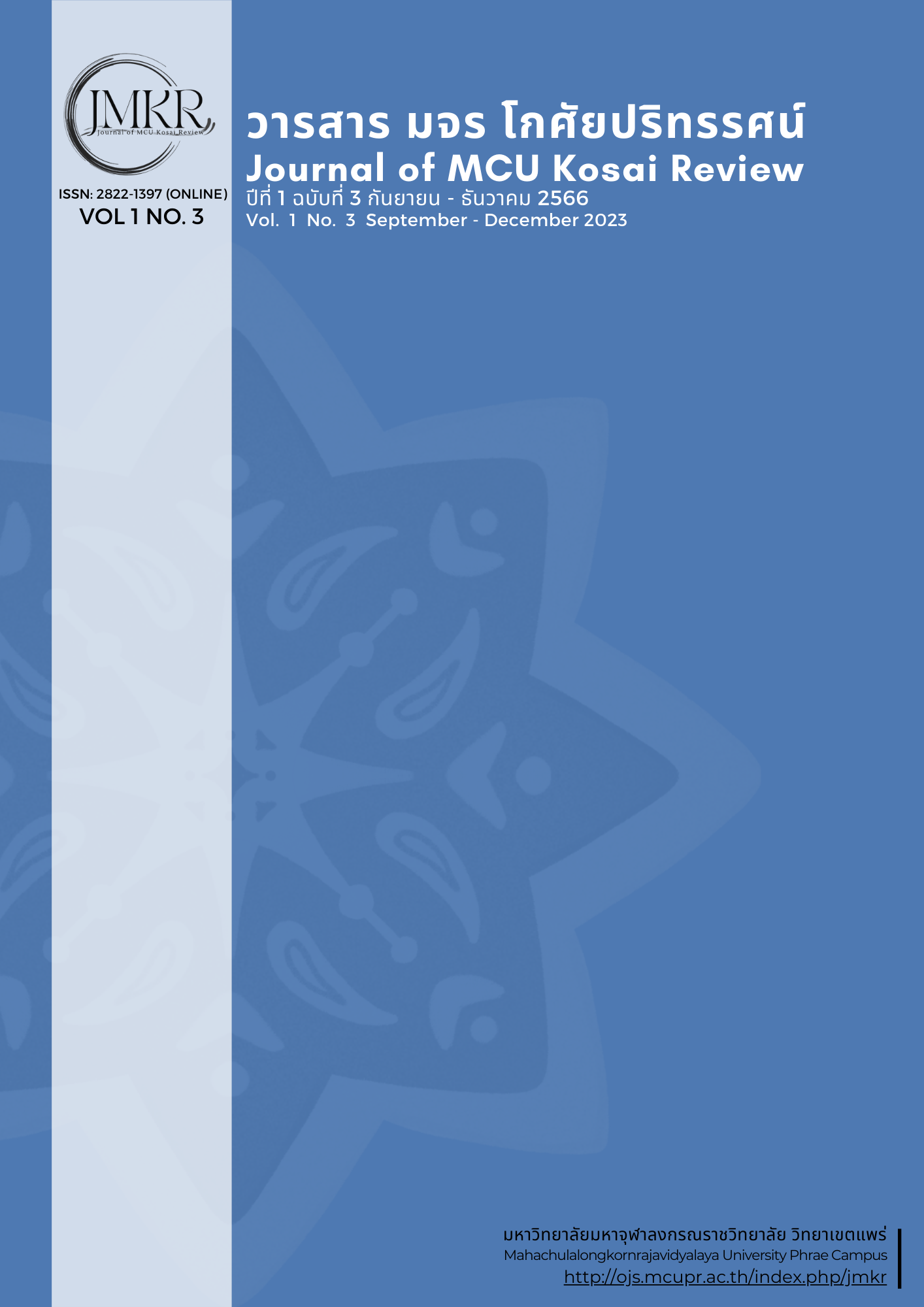Managing The Educational Environment To Bring Happiness to The Learners
Keywords:
Classroom Management, Happinesss, LearnersAbstract
This article aims to study the environment that directly and indirectly affects human learning. A conducive learning environment is not confined to the classroom and is not constrained by time and space. management of various factors of the internal environment of educational institutions in learning conditions that will encourage learners to learn and develop in all aspects, for example, setting up an environment related to teaching and learning, relationship with peers; Including the cleanliness and orderliness of the building. Facilitation and safety arrangements the condition or state of things that exist around them that exist naturally or may be created may be living things. or not alive That is, physical both inside and outside the classroom. should be arranged appropriately conducive to learning to support teaching and learning conducive to learning Classroom atmosphere plays an important role in fostering interest in learning for learners, making them enthusiastic. The new generation must use learning management that focuses on self-experience as a learning medium that builds knowledge and understanding. and imagination that positively affects individual competency behaviors. If the teacher can create this knowledge to happen to the students, it is counted as the teacher's duty to develop the nation's youth. which is an important factor in creating happiness strength for society and the nation
References
กระทรวงศึกษาธิการ. (2545). คู่มือการตรวจสอบและประเมินสถานศึกษาเกณฑ์คุณภาพสำหรับสถานศึกษาสังกัดสำนักงานคณะกรรมการการประถมศึกษาแห่งชาติและกรมสามัญ. กรุงเทพฯ :สำนักงานคณะกรรมการข้าราชการครู.
กิติยวดี บุญซื่อ และคณะ. (2540). ทฤษฎีการเรียนรู้อย่างมีความสุข. กรุงเทพมหานคร: สำนักงานคณะกรรมการการศึกษาแห่งชาติสำนักนายกรัฐมนตรี.
ขัชพล ทรงสุนทรวงศ์.(2543). ทรัพยากรธรรมชาติและสิ่งแวดล้อม. กรุงเทพฯ: โรงพิมพ์โอเดียนสโตร์.
ณิรดา เวชญาลักษณ์. (2562). หลักการบริหารจัดการชั้นเรียน. (พิมพ์ครั้งที่ 2). กรุงเทพฯ: จุฬาลงกรณ์มหาวิทยาลัย.
ปฏิคม พงษ์ประเสริฐ. (2550). การศึกษาการจัดสภาพแวดล้อมและการบริการในโรงเรียนเทศบาล สังกัดเทศบาลเมืองนครนายก. กรุงเทพฯ: มหาวิทยาลัยศรีนครินทรวิโฒ.
พรรณี ชูทัย. (2522). จิตวิทยาการเรียนการสอน. กรุงเทพฯ: วรวุฒิการพิมพ์. มหาวิทยาลัย.
พระพรหมคุณาภรณ์ (ป.อ. ปยุตฺโต). (2555). พุทธธรรมฉบับปรับขยาย. พิมพ์ครั้งที่ 32, กรุงเทพฯ: สำนักพิมพ์ผลิธัมม์.
พลสัณห์ โพธิ์ศรีทอง. (2555). คุณลักษณะ 10 ประการของครูพันธุ์ใหม่. เอกสารประกอบการประชุม ครั้งที่ 22 วันที่ 21 มี.ค. 2555. ที่มาจาก: http://www.sammajivasil.net/news11.htm.
วิจารณ์ พานิช. (2558). วิถีสร้างการเรียนรู้เพื่อศิษย์ ในศตวรรษที่ 21. วารสารนวัตกรรมการเรียนรู้. 1(2), 3-14.
ศุพิธาน์ ริยาพันธ์. (2557). ความสัมพันธ์ระหว่างแบบสัมพันธภาพความผูกพันและการจัดการชั้นเรียนของครูอนุบาลในกรุงเทพมหานคร. ครุศาสตรมหาบัณฑิต สาขาวิชาการศึกษาปฐมวัย. จุฬาลงกรณ์มหาวิทยาลัย
สวัสดิ์ โนนสูง. (2543). ทรัพยากรธรรมชาติและสิ่งแวดล้อม. กรุงเทพมหานคร : โรงพิมพ์โอเดียนสโตร.
สันติ บุญภิรมย์. (2557). การบริหารจัดการในห้องเรียน. (Classroom Management). กรุงเทพมหานคร: ทริปเพิล เอ็ดดูเคชั่น .
สำนักงานคณะกรรมการพลังงานแห่งชาติ. (2544). สถาบันสิ่งแวดล้อมไทย. ยุทธศาสตร์ใหม่เพื่อการอนุรักษ์พลังงานและสิ่งแวดล้อม. กรุงเทพมหานคร: สำนักงานคณะกรรมการพลังงานแห่งชาติ.
มหาจุฬาลงกรณราชวิทยาลัย. พระไตรปิฎกภาษาไทย ฉบับมหาจุฬาลงกรณราชวิทยาลัย. กรุงเทพมหานคร: โรงพิมพ์มหาจุฬาลงกรณราชวิทยาลัย, 2539.




